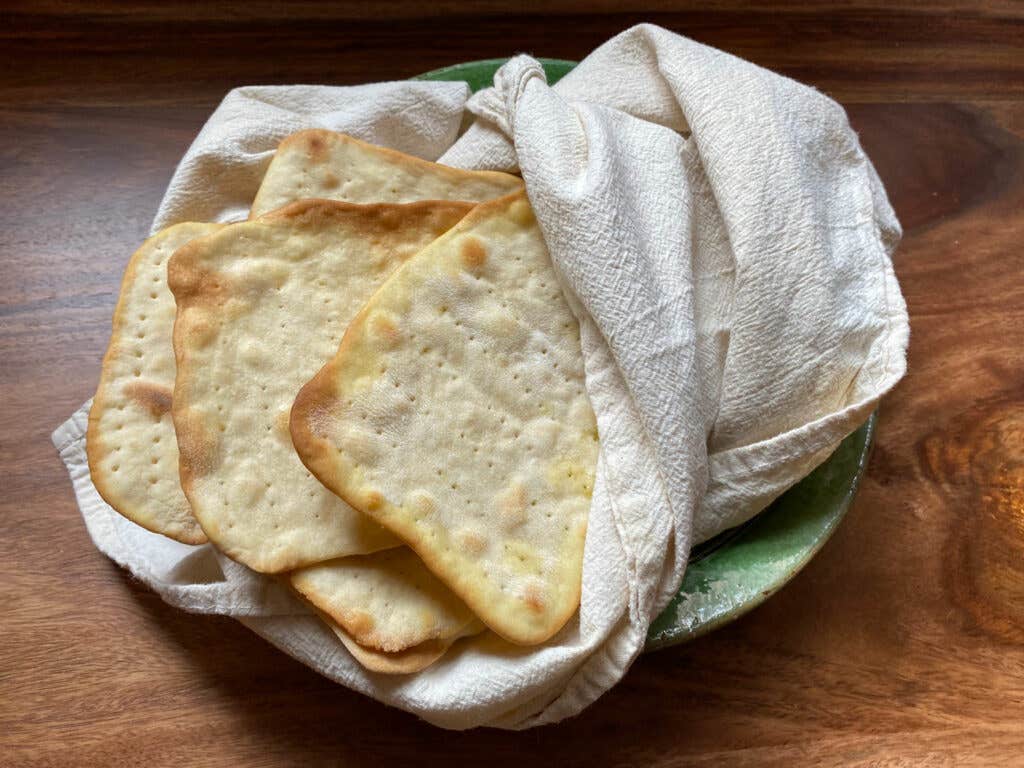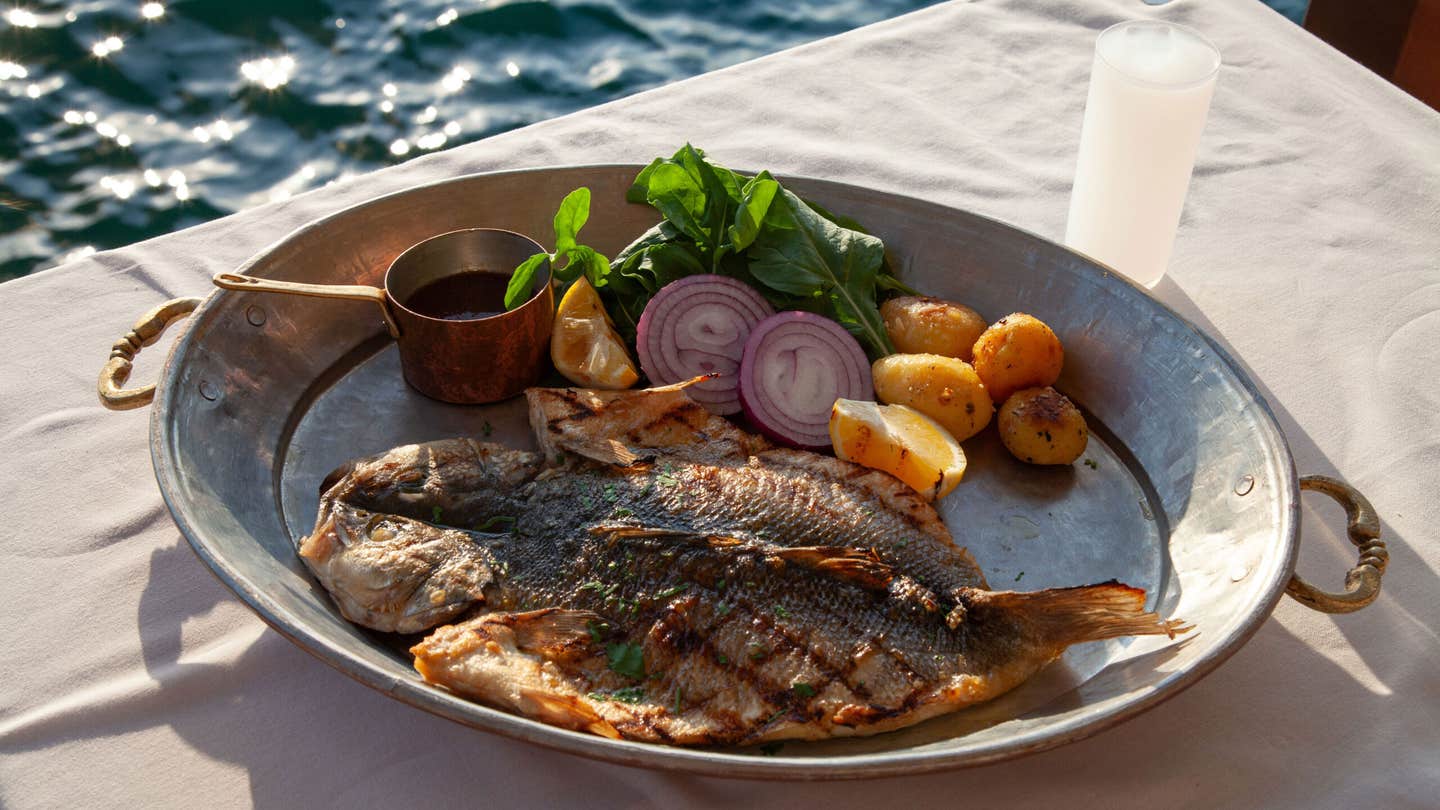Seder in The Time of Corona
A Catholic family quarantined in Baltimore with a Jewish “plus one” celebrates Passover amid the pandemic.
- Serves
makes 12 crackers
- Time
1 hour

One month ago, when Tulane University wisely shut its doors to prevent the spread of Covid 19, my son Jack came home to Baltimore with his Manhattan-born-and-raised girlfriend, Ava, in tow. The idea was that she’d stay with us just until the coast cleared at home. Now that New York and New Orleans are both outbreak hot spots, that decision seems like a lifetime ago.
The first week of her stay, we kept the house clean. Jack took her dishes to the sink well before she could. The atmosphere was one of polite reserve. For Ava’s part, I never saw a stray item of hers left amongst my son’s laundry/shoes/books and the similar detritus from his 16-year-old brother and 12-year-old sister. I knew she missed her family, and I knew she was worried about them. I could tell she still felt more like a guest than truly “in the mix,” as my husband and I say about the kids’ friends who spend lots of time at our house.

So when Ava mentioned that she’d like to host a Seder supper for us as a way to say thank you, we were all enthusiastically on board. My great grandparents were Jewish and, although that’s where it ended in our family, I was familiar with the traditions of Seder. For my three kids, however, this would be a brand-new experience.
I began to text Ava links to all of my favorite recipes on Saveur.com that we might consider. Matzo ball soup? I’d always wanted to learn to make a proper version. While we’re at it, why not make the matzo from scratch? I was certainly embracing baking these days. And what was this brei, a matzo-and-scrambled-egg comfort food? Never tried it, but sounded right for these times. Brisket made with just three ingredients? Yes! And to really keep things easy, we could skip step one in this kugel recipe for a simple potato version. Bitter herbs? Would an arugula salad, minus the Parmesan, work for that? Here was a horseradish mayo we could serve with roasted root vegetables.
And that is when I learned that Ava could not cook. She’d been planning to have all the food sent from her favorite places in New York. Of course a Manhattan upbringing would mean the world at your door with a phone call, so why would you need to cook anything? (My own years there had involved a string of beloved restaurants, and a very under-utilized galley kitchen.) This also explained her gracious and somewhat stunned appreciation when we made homemade pasta a few days into her stay.
We would celebrate Passover (new to us), and we would cook everything from scratch (new to her). We settled on a menu, got up early to snag a curbside pickup time at the grocery store, and began planning.
Though we haven’t sat down to the actual meal yet, we turned the matzo-making into a team-building exercise, taking turns rolling one out then pricking it with a fork to prevent it from bubbling up in the oven. Homemade matzo is a snap—a simple combination of flour and water that cooks into a wonky-but-tasty cracker nothing like the store-bought version. We set aside a few of the pieces to be coated in caramel, dark chocolate, and flaky sea salt, a dessert Ava knew as matzo brittle.
In an attempt to impart the ways of the kitchen before she heads home, I occasionally go all Julia Child on her, as in “French toast is just eggs and milk—easy!” She plans to teach us the story behind the Seder supper, so she did have something sent from New York: Ten costume masks representing the ten plagues on Egypt. (Frogs! Locusts! Lice! Not Covid!) In other news, I am happy to report that just yesterday, I tripped over a pair of Ava’s shoes that were strewn with all the others in the mud room.
Ingredients
- 2¼ cups (11¼ oz.) all-purpose flour, plus more for kneading and rolling
- ½ tsp. kosher salt
- 1 Tbsp. extra-virgin olive oil, plus more for brushing
- Flaky sea salt, for garnish (optional)
Instructions
Step 1
Step 2
Step 3
- Preheat the oven (with one of its racks positioned in the center) to 500°F for at least 45 minutes before you plan to bake the matzo. Line 2 large baking sheets with parchment paper and set them aside.
- Meanwhile, in a large bowl, mix together the flour and kosher salt. Make a well in the center and add ¾ cup cold water and the olive oil. Using a wooden spoon, mix until the dough comes together, adding up to an additional ¼ cup of water, one teaspoon at a time, if needed. Lightly flour a clean work surface, turn the dough out onto it and knead until it comes together in a mostly-smooth ball, about 5 minutes. Divide the dough in half, then cut each half into 6 equal pieces (about 1½ ounces each). Place the 12 pieces on a piece of parchment paper, cover with plastic wrap, and set aside to rest at room temperature for 20 minutes.
- Lightly flour your work surface again, then use a rolling pin to sheet one of the pieces of dough out to a 6- by 4-inch rectangle. Transfer the sheet of dough to one of the parchment-lined baking sheets, then prick it all over with a fork. Repeat with the remaining pieces, fitting 4 matzos on each sheet. Transfer one pan of crackers to the oven and bake until just the matzo is beginning to brown in spots on the bottom, 4–6 minutes. Using tongs, flip the crackers and continue baking until just crisp, 2–4 minutes more. Remove from the oven, brush lightly with olive oil, and sprinkle with flaky sea salt if desired. Continue baking the rest of the dough, one pan at a time, in this manner until all of the matzo is cooked. Serve warm or at room temperature. Cooled matzo crackers will keep in an airtight container for up to one week.
Keep Reading
Continue to Next Story










